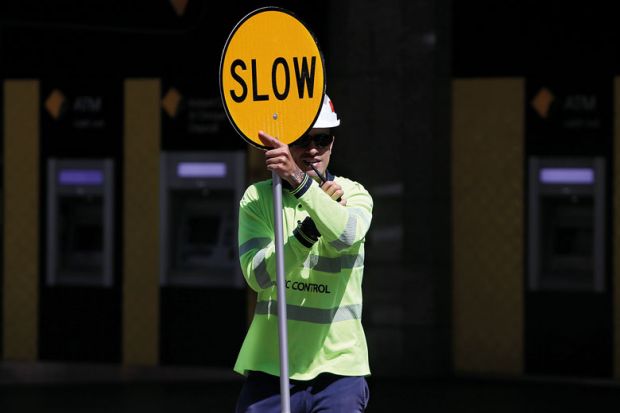Visa processing chaos is just the latest factor splitting Australian universities into a “two-tiered sector”, observers have warned.
University of Tasmania vice-chancellor Rufus Black said policies that disadvantaged struggling institutions were in place well before Canberra slowed down the processing of visas for students enrolled with “higher-risk” universities, under a migration strategy aiming to reduce temporary resident numbers.
Professor Black said policies in China had also privileged some Australian universities at others’ expense. For example, cities such as Shanghai and Hong Kong had extended residency rights to graduates of overseas universities ranked among the world’s top 100.
These graduates also have priority access to subsidised housing under an arrangement known as “talent apartments”, and to government jobs – now in hot demand – after changes were made last year to China’s civil service entry requirements.
“What that’s done is to drive most of the volume of Chinese students to the top five Australian universities,” Professor Black said.
He said the low visa refusal rate for Chinese applicants allowed the top universities to recruit heavily from China and gave them more latitude to recruit from countries with higher rejection rates, without jeopardising the advantageous immigration risk scores they earned for having favourable visa rejection and non-compliance records.
“The rest of the universities…are structurally disadvantaged by not having [large] groups of Chinese students,” Professor Black said, adding that Canberra should find a way of meeting its migration objectives without further skewing the distribution of overseas enrolments. “Effectively [it is] capping the number of international students, and that will be a significant whole-of-sector income cut.”
Chinese enrolments are thought to be driven by global rankings, and top Australian universities’ high Chinese enrolment figures left them relatively unaffected by Covid-era border closures. Some managed to increase their international earnings during the pandemic after China moved to recognise degrees obtained online.
Professor Black was one of 16 co-signatories of a letter from vice-chancellors to home affairs minister Clare O’Neil on 5 February. It highlighted “significant financial threats” to the universities affected by “the de-prioritisation of visa caseload processing”.
The 16 institutions estimated that the visa-processing delays would collectively cost them A$310 million (£161 million) this year. That equates to 38 per cent more than their combined international education revenue losses in the first year of the pandemic, and almost half of the downturn they sustained between 2019 and 2022.
Three of the 16 institutions are among the 24 universities that currently have the best immigration risk ratings. Some fear this will change when the ratings are updated in March, because of factors beyond their control.
The ratings are influenced by visa rejections, which are at record highs for higher education applicants. Sources say this is because officials are artificially increasing the number of rejections to curtail immigrant numbers, although the Department of Home Affairs denies this.
Some Australian media have publicly identified 16 universities with higher risk ratings. Angela Lehmann, head of research with the Lygon Group consultancy, said these reports were being circulated overseas, compounding the problems for the affected institutions.
“It’s only going to make the situation worse, especially in rankings-obsessed countries like China,” she said. “It’s not clear to the students what a risk rating is.”
Professor Black said Chinese students were a “high-margin proposition” for the universities that could attract them, with low recruitment costs and large rewards, but students from elsewhere offered lower margins. The pool of universities able to rely on international earnings to plug funding shortfalls was shrinking, he said.
“That model isn’t really going to keep broadly supporting the sector,” he said. “The two-tier system is really taking off.”




